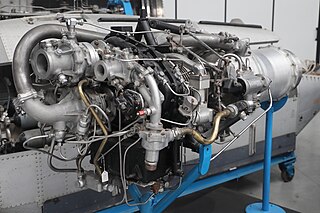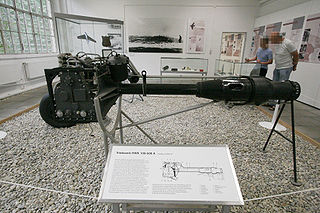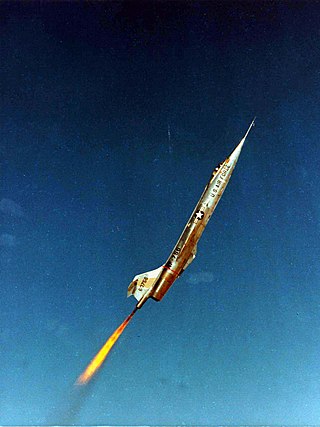
A hybrid-propellant rocket is a rocket with a rocket motor that uses rocket propellants in two different phases: one solid and the other either gas or liquid. The hybrid rocket concept can be traced back to the early 1930s.

A rocket engine uses stored rocket propellants as the reaction mass for forming a high-speed propulsive jet of fluid, usually high-temperature gas. Rocket engines are reaction engines, producing thrust by ejecting mass rearward, in accordance with Newton's third law. Most rocket engines use the combustion of reactive chemicals to supply the necessary energy, but non-combusting forms such as cold gas thrusters and nuclear thermal rockets also exist. Vehicles propelled by rocket engines are commonly used by ballistic missiles and rockets. Rocket vehicles carry their own oxidiser, unlike most combustion engines, so rocket engines can be used in a vacuum to propel spacecraft and ballistic missiles.
The XLR11, company designation RMI 6000C4, was the first liquid-propellant rocket engine developed in the United States for use in aircraft. It was designed and built by Reaction Motors Inc., and used ethyl alcohol and liquid oxygen as propellants to generate a maximum thrust of 6,000 lbf (27 kN). Each of the four combustion chambers produced 1,500 lbf (6.7 kN) of thrust. The engine was not throttleable but each chamber could be turned on and off individually.

The F-1, commonly known as Rocketdyne F-1, is a rocket engine developed by Rocketdyne. This engine uses a gas-generator cycle developed in the United States in the late 1950s and was used in the Saturn V rocket in the 1960s and early 1970s. Five F-1 engines were used in the S-IC first stage of each Saturn V, which served as the main launch vehicle of the Apollo program. The F-1 remains the most powerful single combustion chamber liquid-propellant rocket engine ever developed.

The J-2, commonly known as Rocketdyne J-2, was a liquid-fuel cryogenic rocket engine used on NASA's Saturn IB and Saturn V launch vehicles. Built in the United States by Rocketdyne, the J-2 burned cryogenic liquid hydrogen (LH2) and liquid oxygen (LOX) propellants, with each engine producing 1,033.1 kN (232,250 lbf) of thrust in vacuum. The engine's preliminary design dates back to recommendations of the 1959 Silverstein Committee. Rocketdyne won approval to develop the J-2 in June 1960 and the first flight, AS-201, occurred on 26 February 1966. The J-2 underwent several minor upgrades over its operational history to improve the engine's performance, with two major upgrade programs, the de Laval nozzle-type J-2S and aerospike-type J-2T, which were cancelled after the conclusion of the Apollo program.

The Rocketdyne H-1 was a 205,000 lbf (910 kN) thrust liquid-propellant rocket engine burning LOX and RP-1. The H-1 was developed for use in the S-I and S-IB first stages of the Saturn I and Saturn IB rockets, respectively, where it was used in clusters of eight engines. After the Apollo program, surplus H-1 engines were rebranded and reworked as the Rocketdyne RS-27 engine with first usage on the Delta 2000 series in 1974. RS-27 engines continued to be used up until 1992 when the first version of the Delta II, Delta 6000, was retired. The RS-27A variant, boasting slightly upgraded performance, was also used on the later Delta II and Delta III rockets, with the former flying until 2018.

The Reaction Motors LR99 engine was the first large, throttleable, restartable liquid-propellant rocket engine. Development began in the 1950s by the Reaction Motors Division of Thiokol Chemical Company to power the North American X-15 hypersonic research aircraft. It could deliver up to 57,000 lbf (250 kN) of thrust with a specific impulse of 279 s (2.74 km/s) or 239 s (2.34 km/s) at sea level. Thrust was variable from 50 to 100 percent, and the restart capability allowed it to be shut down and restarted during flight when necessary.

The de Havilland Spectre is a rocket engine that was built by the de Havilland Engine Company in the 1950s. It was one element of the intended mixed power-plant for combination rocket-jet interceptor aircraft of the Royal Air Force, such as the Saunders-Roe SR.177.

The Walter HWK 109-509 was a German liquid-fuel bipropellant rocket engine that powered the Messerschmitt Me 163 Komet and Bachem Ba 349 aircraft. It was produced by Hellmuth Walter Kommanditgesellschaft (HWK) commencing in 1943, with licensed production by the Heinkel firm's facilities in Jenbach, Austria.

The Bristol Siddeley BS.605 was a British take off assist rocket engine of the mid-1960s that used hydrogen peroxide and kerosene propellant.

The Lockheed NF-104A was an American mixed-power, high-performance, supersonic aerospace trainer that served as a low-cost astronaut training vehicle for the North American X-15 and projected Boeing X-20 Dyna-Soar programs.

The Armstrong Siddeley, later Bristol SiddeleyGamma was a family of rocket engines used in British rocketry, including the Black Knight and Black Arrow launch vehicles. They burned kerosene fuel and hydrogen peroxide. Their construction was based on a common combustion chamber design, used either singly or in clusters of up to eight.

The Napier Scorpion series of rocket engines are a family of British liquid-fuelled engines that were developed and manufactured by Napier at the Napier Flight Development Establishment, Luton, in the late 1950s. The Scorpion range were designed and flight tested as boosters to improve aircraft take-off performance.
The Armstrong Siddeley Snarler was a small rocket engine used for mixed-power experiments with an early turbojet engine. and was the first British liquid-fuelled rocket engine to fly.
The expansion-deflection nozzle is a rocket nozzle which achieves altitude compensation through interaction of the exhaust gas with the atmosphere, much like the plug and aerospike nozzles.
The RL60 was a planned liquid-fuel cryogenic rocket engine designed in the United States by Pratt & Whitney, burning cryogenic liquid hydrogen and liquid oxygen propellants. The engine runs on an expander cycle, running the turbopumps with waste heat absorbed from the main combustion process. This high-efficiency, waste heat based combustion cycle combined with the high-performance liquid hydrogen fuel enables the engine to reach a very high specific impulse of up to 465 seconds in a vacuum. The engine was planned to be a more capable successor to the Aerojet Rocketdyne RL10, providing improved performance and efficiency while maintaining the installation envelope of the RL10.
The BMW 109-718 was a liquid-fuelled rocket engine developed by BMW at their Bruckmühl facility, in Germany during the Second World War.

The Walter HWK 109-500 was a liquid-fuelled rocket engine developed by Walter in Germany during the Second World War.

The SEPR 84 is a family of liquid-propellant rocket engines used as boosters for the Dassault Mirage III mixed-power high-altitude interceptor aircraft of the 1960s. The engine was one of several similar developed by SEPR.
The MARC-60, also known as MB-60, MB-XX, and RS-73, is a liquid-fuel cryogenic rocket engine designed as a collaborative effort by Japan's Mitsubishi Heavy Industries and US' Aerojet Rocketdyne. The engine burns cryogenic liquid oxygen and liquid hydrogen in an open expander cycle, driving the turbopumps with waste heat from the main combustion process.














